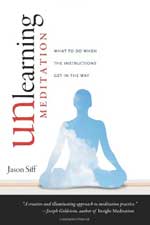
We’re currently reading Jason Siff’s Unlearning Meditation: What to Do When the Instructions Get In the Way at the Tricycle Book Club. For the next four weeks, Siff will be providing you with articles, meditation instructions, and most significantly, an opportunity for you to journal your meditation sittings and look more closely at what happens in meditation. Below are Siff’s basic meditation instructions for “recollective awareness meditation.” Pick up a copy and join the discussion.
Basic Meditation Instructions
Listed below are the basic meditation instructions I give to beginning meditators. If you already have a meditation practice, you can try these instructions, or you can meditate in the ways you are accustomed.
- Find a quiet spot to meditate where you most likely won’t be disturbed by others or by the phone. Decide how long you are going to sit for (anywhere from 10 to 40 minutes) and either set an alarm or have a clock nearby to peek at on occasion.
- Sit in a comfortable posture, one that you feel you will not change for the duration of the sitting, either on a chair, couch, or on a meditation mat or cushion. But if you do need to move during the meditation sitting, try to move slowly and quietly into a more comfortable posture.
- Close your eyes and bring your attention to the touch of your hands resting one on top of the other in your lap. But don’t hold your attention there. Instead, allow your mind to go where it will. If you are drawn into thoughts, feelings, memories, or fantasies, let your attention go there. Your attention may at times also be drawn to sounds, bodily sensations, fragrances or odors, or your breath.
- When you feel that you have been away from the contact of your hands for several minutes, you can remind yourself to come back to the hands and stay there for a few seconds before allowing your mind to wander again.
- If you feel restless, bored, confused, discouraged, elated, sleepy, upset, anything, it is okay. You don’t have to do anything about it, or, you can bring your attention back to the touch of your hands. But if you do, just stay with your hands for a little while, and then, if your mind wants to go back into the feelings or thoughts that you left, you can let it. If something else draws your attention, you can let it.
- When the meditation sitting is over, take a couple of minutes to mentally recall what you can of the sitting. If you would like to journal your meditation sitting, just try to write a description of what you remember.
Instructions for Journaling
- Before writing down the sitting, write down the date and time that the sitting took place. This is helpful when referring back to the journal entry.
- There are two basic ways to begin writing it down: to make a list or write a narrative. If you decide to make a list of the events you recall from the sitting, I suggest that you use longer descriptions than single words. You don’t need to write down the sitting in chronological order. You can start with what you remember most easily, and once you have that on paper, you can write down the other things that start to come to mind from the meditation. For those who like to have journal entries in chronological order, you can always rewrite the journal entry afterwards, putting it in order, or mark entries in some way to give a picture of when they occurred.
- Your descriptions do not have to be exact. They just need to be truthful. If a description doesn’t feel accurate, that is fine, as long as you are being honest. We can’t hold ourselves to a high standard of precision and accuracy in this endeavor.
- Try to keep your journal entries focused on what went on during the meditation sitting. In the course of writing things down, you might have some thoughts about an experience. You may write down your afterthoughts, but mark them in a way that shows they did not occur in the sitting (such as by putting them in parentheses).
- You will only remember a fraction of what goes on in many of your sittings. That is perfectly normal. Just write down what you can recollect. That is enough. Some journal entries may be many paragraphs long, while others may just have a couple of sentences.
Thank you for subscribing to Tricycle! As a nonprofit, we depend on readers like you to keep Buddhist teachings and practices widely available.